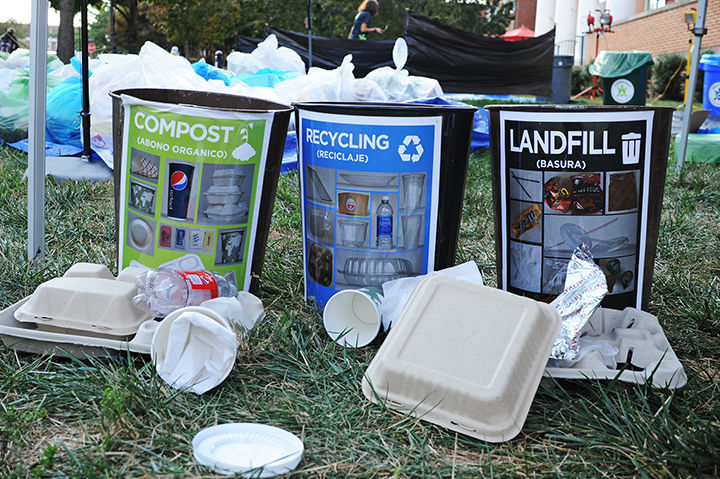
The results of a university waste audit showed significant progress for recycling and composting in various university buildings.
SCS Engineers, an environmental consulting and contracting company, analyzed waste gathered from four dorms, two dining halls and Stamp Student Union and published results in the 2014 Waste Stream Analysis report.
Cindy Felice, Department of Residential Facilities associate director, said the report could help departments understand how waste disposal issues compare with the past two campuswide waste audits, which were conducted in 2002 and 2008.
The audit showed about 20 percent of all materials disposed of in dorm recycling bins were not recyclable. A majority of the non-recyclable material was compostable waste like food, and dorms do not have compost bins.
“This [report] really helped us understand where our problems are and it helped us understand how we could get our recycling stream cleaner and purer,” Felice said.
In 2002, 27 percent of all recyclable paper fell into dorm trash cans instead of recycling bins. That number dropped to 8 percent in 2014, showing officials a significant improvement in students’ awareness of recycling.
“Overall it looked very good to what it used to be in the past,” Felice said. “We’re very proud of it. … And I think it shows we have done our part in the campus’ increased recycling efforts.”
In Stamp, about 25 percent of recycling was contaminated, with 13 percent of that compostable. The audit found about 11 percent of all materials that were composted to be contaminated.
About half of all recyclable paper ended up in trash cans instead of recycling bins in 2002. This number has been steadily decreasing since then, with 10 percent of all paper thrown in the trash in 2008 and 8 percent in 2014.
Currently, signs instructing users where to dispose certain items are posted on some waste bins and a video on the Stamp Green Choices webpage helps explain the trash disposal processes.
Dan Wray, Stamp’s assistant director of facilities, said Stamp is working on an outreach campaign for the fall, with funding from the Student Sustainability Fund, which will be aimed at promoting waste-consciousness.
“We understand that sorting waste can seem complicated,” Wray said. “We are focused now on helping our students and guests to be aware of the basics so they have a good foundation to build on.”
Allison Lilly, sustainability and wellness coordinator in the Department of Dining Services, said the department had the lowest rates of contamination in composting and recycling, but the audit can help alert the department of the compostable or recyclable materials still in landfills
Only about 10 percent of all material thrown into recycling and composting bins in dining halls is incorrectly placed.
The audit found less styrofoam in dining hall trash in 2014 — 1 percent — compared to 10.3 percent in 2002 and 15 percent in 2008. The amount of food thrown into the landfill bin instead of the compostable bin went down from 60 percent in 2008 to 50 percent in 2014.
Lilly said she’d like to see greater overall waste reduction, through measures such as increasing the use of reusable mugs and carryout containers. Dining Services offers a 20-cent discount to anyone bringing their own mug or reusable cup to encourage more sustainable behaviors.
“We are excited to continue to engage students and the campus in these important initiatives,” Lilly said. “We hope to help connect waste reduction and separation efforts with our other projects to help increase engagement and enthusiasm for the programs.”
Lilly and Wray agreed that while the numbers for the dining halls and Stamp are better, there is still room for improvement. Dining Services and Stamp will continue to work with student groups and other departments to develop sustainable strategies, they said.
“What’s happening next … we all say, ‘OK, what do we need to do to improve and reduce the contamination where we still have it?’” Felice said. “We want to work for greater education to try and get people to learn how to put stuff in the right containers.”



